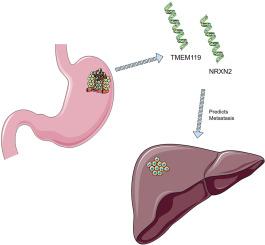TMEM119和NRXN2作为胃癌肝转移的预后生物标志物
IF 3
Q3 ONCOLOGY
引用次数: 0
摘要
胃癌(GC)是一种常见的消化道恶性肿瘤,死亡率高,主要是由于肝转移。驱动这一过程的潜在分子机制仍然知之甚少。本研究旨在寻找胃癌肝转移的新型预后生物标志物。方法分析来自癌症基因组图谱(TCGA)数据库的非转移性、肝转移性和其他转移性胃癌患者样本的mRNA表达数据。采用加权基因共表达网络分析(Weighted gene共表达network analysis, WGCNA)鉴定与肝转移相关的关键基因模块和枢纽基因。根据差异表达、Kaplan-Meier生存分析确定的预后价值和单变量Cox回归模型进行风险评估,筛选潜在的生物标志物。研究结果随后在380例胃癌患者的独立队列中得到验证。结果WGCNA鉴定出一个与胃癌肝转移相关的基因模块(MEgrey)。在该模块中,TMEM119和NRXN2被鉴定为关键枢纽基因,其在肝转移组中的表达明显高于非转移组和其他转移组。TMEM119或NRXN2的高表达与较短的总生存期(OS)相关,并表明死亡风险增加(HR > 1)。这些发现在我们的验证队列中得到了证实。结论tmem119和NRXN2是预测胃癌患者肝转移的有希望的预后生物标志物,可能成为潜在的治疗靶点。本文章由计算机程序翻译,如有差异,请以英文原文为准。

TMEM119 and NRXN2 as prognostic biomarkers for liver metastasis in gastric cancer
Background
Gastric cancer (GC) is a common digestive malignancy with high mortality, primarily due to liver metastasis. The underlying molecular mechanisms driving this process remain poorly understood. This study aimed to identify novel prognostic biomarkers for GC liver metastasis.
Methods
We analyzed mRNA expression data from non-metastatic, liver-metastatic, and other-metastatic GC patient samples from The Cancer Genome Atlas (TCGA) database. Weighted gene co-expression network analysis (WGCNA) was employed to identify key gene modules and hub genes associated with liver metastasis. Potential biomarkers were screened based on differential expression, prognostic value determined by Kaplan-Meier survival analysis, and risk assessment via a univariate Cox regression model. The findings were then validated in an independent cohort of 380 GC patients.
Results
The WGCNA identified a gene module (MEgrey) significantly correlated with GC liver metastasis. Within this module, TMEM119 and NRXN2 were identified as key hub genes whose expression was significantly higher in the liver metastasis group compared to the non-metastatic and other-metastatic groups. High expression of either TMEM119 or NRXN2 was associated with shorter overall survival (OS) and indicated an increased risk of mortality (HR > 1). These findings were confirmed in our validation cohort.
Conclusion
TMEM119 and NRXN2 are promising prognostic biomarkers for predicting liver metastasis in GC patients and may serve as potential therapeutic targets.
求助全文
通过发布文献求助,成功后即可免费获取论文全文。
去求助
来源期刊

Advances in cancer biology - metastasis
Cancer Research, Oncology
CiteScore
2.40
自引率
0.00%
发文量
0
审稿时长
103 days
 求助内容:
求助内容: 应助结果提醒方式:
应助结果提醒方式:


